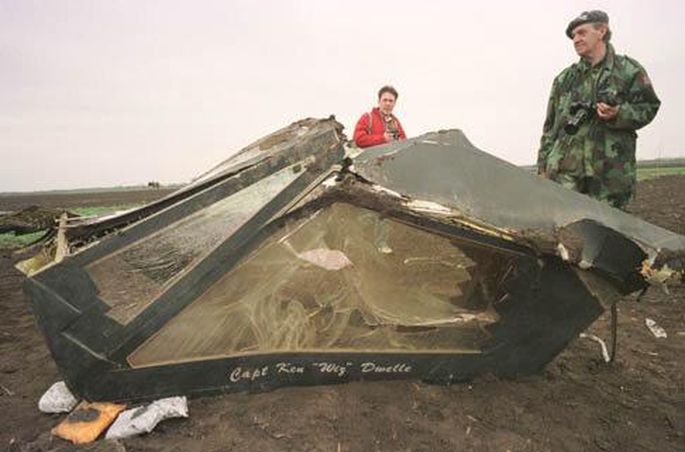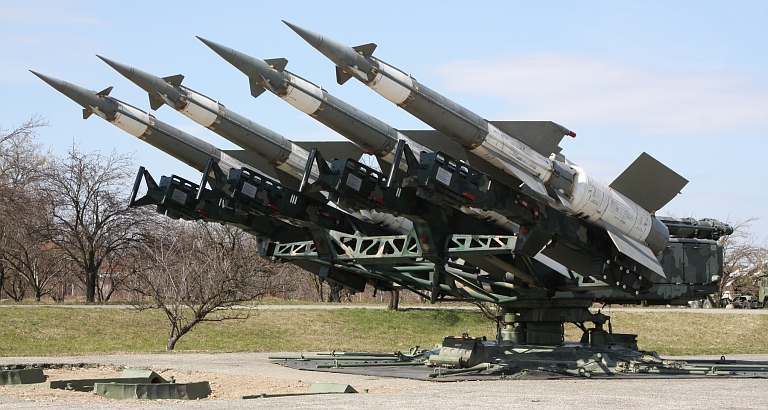 By David Cenciotti
By David CenciottiOn Mar. 27, 1999, the fourth night of Operation Allied Force over Serbia, an F-117 Nighthawk stealth fighter jet was shot down while returning to Aviano airbase, in northern Italy after bombing a target near Belgrade.
U.S. Air Force Lt. Col. Darrell P. Zelko, a veteran of the 1991 Gulf War, was flying a stealth plane from the 49th Fighter Wing, deployed to Italy from Holloman Air Force Base, New Mexico, with the radio callsign “Vega 31″ when he was hit by the Serbian air defense near Novi Sad.
Zelko was flying his third Allied Force sortie and he was egressing the target area when his since-then invincible, F-117 was hit, forcing him to eject behind the enemy lines at 20.45 LT.
An MH-53M, MH-53J and MH-60 aircrew along with Special Tactics Airmen responded to the emergency and within 5 hours of being alerted, AFSOC (Air Force Special Operations Command) assets, coordinated by E-3 AWACS and supported by several specialized platforms, including an EC-130E Commando Solo and A-10 in Sandy role, rescued the F-117 pilot prior to enemy forces who were bearing down on the downed pilot’s location.
How the Serbian air defense managed to achieve the first and only stealth plane is open to debate.
According to the Serbs, Belgrade’s air defenses operators had found they could detect stealth planes using some slightly modified Soviet radars. In particular, the modifications involved using long wavelengths that enabled such radar systems to detect the stealth planes at relatively short range when the low radar cross section of the aircraft was affected when the bomb bay doors were open to drop 2,000 lb bombs.
Moreover, Serbs monitored U.S. and allied radio comms on UHF and VHF frequencies (mostly unencrypted – as happened 12 years later during the opening phases of Operation Odyssey Dawn over Libya) and were also able to intercept NATO plane’s ATO (Air Tasking Orders) that enabled them to put anti-aircraft batteries at positions close to the ground targets.
In other words: Serbian air defenses knew where and when to look at incoming bombers.
The F-117 82-0806 (whose remains are exhibited at Belgrade Air Museum) was shot down by the 3rd Battalion of the 250th Air Defence Missile Brigade of the Army of Yugoslavia, with one of several missiles fired by an S-125 “Neva” missile system (NATO reporting name, SA-3 “Goa”) at a distance of about 8 miles.
According to Sergeant Dragan Matić, the soldier later identified as the operator who fired the missiles, the stealth plane was detected at a range of about 50 to 60 kilometres and the surface-to-air missile radar was switched on for no more than 17 seconds to prevent the site to be detected by the NATO’s SEAD (Suppression of Enemy Air Defense) aircraft.
Some pieces of the 82-0806 shot down near Novi Sad were reportedly sent to Russia, to be used in developing anti-stealth technology.
On May 2, 1999, a 31FW F-16C was shot down by the 250th Air Defense Missile Brigade becoming the second and last allied plane to be shot down by Serbian air defenses during Allied Force.
Image credit: Lockheed Martin, Serbian Air Force.
 By Guy de Launey
By Guy de LauneyDale Zelko and Zoltan Dani talk about how they forged their friendship Continue reading the main story
A former US Air Force pilot and the man who shot his stealth plane down during Nato's operation in Serbia have struck a remarkable friendship.
Breaking bread with the enemy is one thing. Making it together is a step that former foes do not usually take.
But in Zoltan Dani's kitchen, that is exactly what is happening. Once the commander of a krack Yugoslav anti-aircraft rocket unit, the former colonel has swapped his camouflage for an apron and now runs a successful bakery.
Even more remarkably, kneading the dough beside him is former United States Air Force pilot, Dale Zelko.
From foes to friends: Dale Zelko and Zoltan Dani say they feel like brothers now
The two men were on opposite sides in 1999, when Nato air strikes rocked Belgrade and other key targets. And they were the protagonists in one of the most remarkable incidents of Operation Allied Force.
Dale Zelko flew the F117 "stealth fighter" - a warplane so advanced that it was all but invisible to enemy radar.
But on the night of 27 March 1999 he was uncomfortable. Weather conditions meant the stealth fighters would not have their usual escort of "Prowler" electronic jamming planes or F16s firing anti-radar missiles.
"I'd never felt so strongly - if there was ever a night, a mission for an F117 to get shot down, it would be this one. I wasn't surprised when it happened," he says.
Nice shot
Zoltan Dani had problems of his own. He commanded a unit which was low on resources and vulnerable to attack by the F16s. But his men were not short on morale or skill.
Each night he would move his unit from place to place - operating the equipment in 20-second bursts to avoid the attention of anti-radar missiles.
Citing Serbian electronics genius Nikola Tesla as an inspiration, Zoltan had the equipment modified so it would operate beyond the usual wavelengths.
Perhaps it was this which allowed him to detect Dale Zelko's stealth fighter.
"When it hit, it felt very, very good. Like scoring the winning goal in a football match," says Mr Dani.
The US pilot's perspective was naturally a little different. But once he had ejected from his now uncontrollable plane, Mr Zelko had some surprisingly generous thoughts.
"I thought about the Serbian SAM (surface-to-air missile) operator, imagining having a coffee and conversation with this guy, saying to him: 'Really nice shot.' I had this huge respect for him and the Serbian people."
'Message of peace'
The initial suggestion came from Mr Dani's son, Atila, who had seen footage of Dale online. It was taken up by Serbian documentary-maker Zeljko Mirkovic, who was then completing a film about the former rocket unit commander called The 21st Second.
He contacted the now-retired pilot via the US Air Force. And for Dale Zelko it could not have been a more welcome communication.
"As soon as I read the idea of meeting the man who shot me down, my immediate reaction was: yes, absolutely - and I became obsessed with the idea. I felt I had to connect deeply and personally with this person and the Serbian people. It became a mission of passion for me."
Several years of correspondence followed. The two former military men say they shared their stories, emotions and ideas as they worked towards a face-to-face encounter.
That finally came last year - with Zeljko Mirkovic's camera also in attendance. His documentary about the relationship between Dale and Zoltan is called The Second Meeting. And he thinks its story is relevant around the world.
"Our three families - Dale's, mine, Zoltan's - shared the same values, about believing in the family, believing in peace. We all believed we had the right to send the message - hope, peace - which could be accepted universally."
But the relationship between the two old adversaries has gone far beyond the boundaries of the film. They have exchanged visits to each other's homes - and their children and wives have also struck up friendships.
Three members of the Zelko family came to Serbia for a week of premieres of The Second Meeting. They stayed at the Dani family home in Kovin, a short distance from Belgrade.
It was striking how comfortable the two families were in each other's company: the older, dark-haired Dani children acting like older siblings to the pre-teen, blonde-haired Zelkos. Meanwhile, the two fathers relaxed with home cooking and coffee.
'Human element'
Still, the friendship has thrown up some intriguing philosophical conundrums. Particularly for Dale Zelko, who first went to Serbia to make war, but returned to make friends.
"I had a question from the audience at the Belgrade premiere: 'After developing a real personal relationship between the families, could you go back in a combat machine against Serbia?' I said absolutely not, that would be impossible. You can no longer remove the human element from it."
The pair hope their story will send a message of tolerance and understanding around the world.
Emerging from another hug with the man who came to bomb his country but whom he now calls brother, Zoltan Dani is happy to be viewed as an example.
"We found a solution to this problem and we're showing other people how to do it. We're saying to people that peace is much better than war. The most important thing is that we communicate and become very good friends - share emotions and feelings."
He smiles, and glances over at the oven.
"And besides apple strudel, we make chocolate cake."
♞ Aviationist | BBC



Tidak ada komentar:
Posting Komentar
Catatan: Hanya anggota dari blog ini yang dapat mengirim komentar.